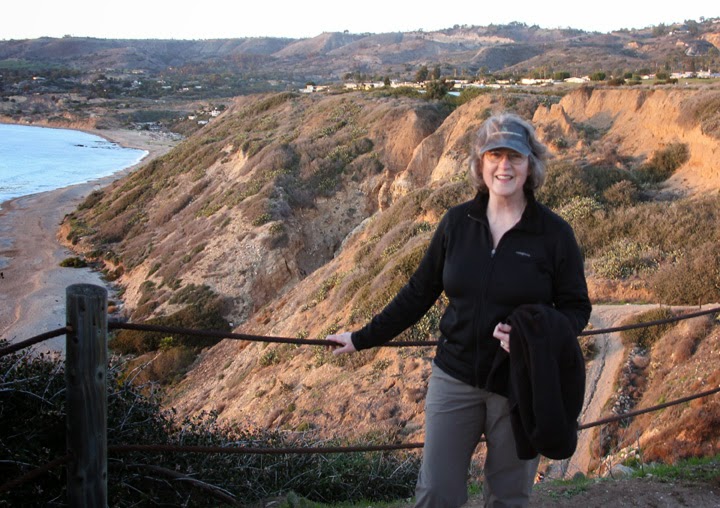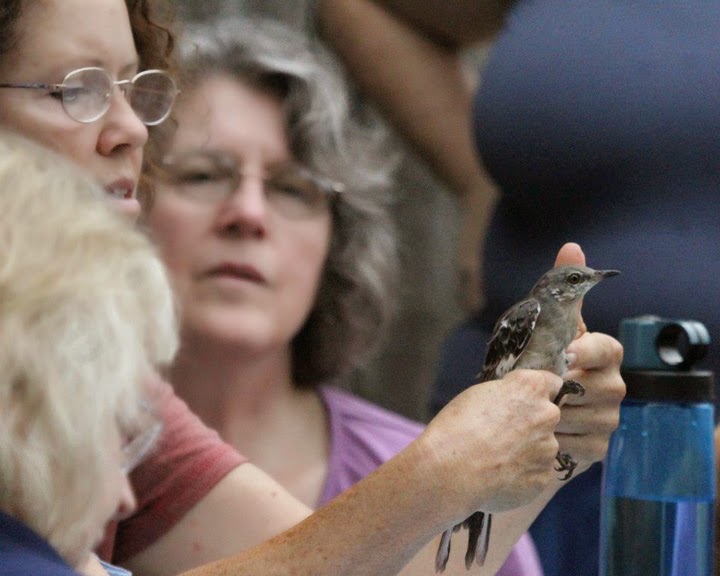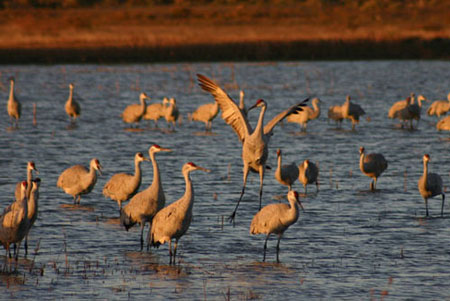Tellico Village is an incorporated community on the western shore of the Tellico Reservoir in Loudon County, Tennessee. The community is suburban in arrangement but each cluster of housing is separated by wooded areas and the entire community borders the Tellico Reservoir, also known as Tellico Lake.
From Joan and Charles Omarzu's deck where a hummingbird feeder hangs, there is a wonderful view of the surrounding countryside, and in the distance, Mount LeConte and other features of the Great Smoky Mountains can be seen.
Joan hung a feeder out last November but did not notice a hummingbird visiting during that season. She also noted later that the feeder was not easily viewed from the window. This year, she initially decided she would not hang a feeder, but on December 2nd, Charles thought he saw a hummingbird around the deck. Joan watched the deck for a while and the hummingbird came to the window and hovered in front of her. She quickly made sugar water and hung a feeder out!
Above, Mark Armstrong, Master Bander for hummingbirds and songbirds in east Tennessee, removes the hummingbird from the trap after it is captured and places it in a mesh bag to hold it safely until he is ready to band it, a time-span that can usually be measured in seconds.
The hummingbird trap was hand-made by Mark, who is a biologist and the bird curator at the Knoxville Zoo, and past president of the Knoxville Chapter of the Tennessee Ornithological Society. A sliding door, positioned on one side of the trap, is opened and closed by the tension of a line attached to a fishing reel that Mark holds in his hand. When the line is pulled tight, the door lifts up. When tension is released the door comes down and captures the hummer inside.
Bird banders are specially trained and licensed volunteers. In addition to earning a songbird banding license, the hummingbird bander spends hundreds of hours specifically training to band hummingbirds. Banders either purchase or make their own equipment. Even the specially numbered bands issued by the Bird Banding Laboratory come on a metal sheet that must be carefully disassembled and the tiny numbered strips formed into rings that will fit the hummingbird's leg. The rings are then placed on a wire in numbered sequence, ready to be opened with pliars and closed again around the banded hummingbird's leg.
This hummingbird's band begins with J43. The J represents a beginning series of numbers, shortening the number sequence recorded and helping banders recognize a band number sequence more quickly.
Friend, Claire Manzo, who has also had a wintering hummingbird at her Tellico Village home in the past, takes a video of the banding process to show their bird club. Claire has organized the Tellico Village birding organization, the Tellico Villiage Birders, and is the current president.
Above, Mark measures the length of the hummingbird's tail feathers and below he measures the length of the beak.
In the image below you see the small stocking that cradles the hummer. Mark counts the gorget feathers that have developed as a part of his record on this juvenile.
The juvenile's bare belly is revealed when Mark blows air through a straw. Both males and females have a bear belly that is concealed by feathers. The belly area is the place where most of the hummingbird's fat is stored. In this image you can also see the tiny foot and the gorget feathers reflecting a deep red as they change with the angle of light.
When Mark weighed the bird, he remarked that this bird had the heaviest weight he had recorded during the winter months. Large fat deposits are usually an indication of a bird getting ready for migration or one that has just arrived at its migrating destination.
The juvenile is molting baby feathers and growing in new rufous ones on his back and head. You can see the mixture of rufous and greenish feathers on his back and the gray and green feathers on his crown that will be replaced by rufous feathers when he matures.
Above, the distinctly rufous colors in the tail feathers.When his examination is completed, Mark places the hummingbird in Joan's hand for release.
Often a Rufous hummingbird relaxes during the examination process and sits in the hand without noticing that it is free to fly. Mark gives the juvenile a gentle nudge with his finger and he buzzes away.
Visit Mark Armstrong's interview earlier this year with Live at Five at Four as he is banding hummingbirds at his home during late summer (a brief commercial precedes the interview). Mark and his wife, Jane, live in Seymour, Tennessee, and having assisted their banding operation a couple of times, I can say they have hundreds of hummingbirds visiting their feeders. The numbers of birds visiting a yard's feeders is influenced by the number of years feeders have been present. Breeding birds are loyal to breeding areas and migrating birds remember their nectar source.
In east Tennessee, report winter hummingbird sightings to Mark Armstrong at Woodthrush@bellsouth.net or 865-748-2224. For a list of contact information for other eastern areas, visit winter reporting on the Hummer Study Group website or report sightings to Bob and Martha Sargent, Rubythroat@aol.com or 205-681-2888.
Western Hummingbirds Wintering in Tennessee
Allen's Hummingbird in Tennessee
Rufous Hummer in Knoxville
Other blog posts on Wintering hummingbirds in Tennessee
In recent years, fourteen species of hummingbirds have been documented in the east during fall and winter months. Visit Bob Sargent's information on wintering hummingbirds
Bob Sargent describes the Rufous Hummingbird as very cold-hardy.
Sargent on wintering Calliopes and the Allen's Hummingbird
Hummingbird banding
Hummingbirds in watercolor
Hummingbird art on Vickie's Sketchbook blog
Cornell's All About Birds: Rufous Hummingbirds
Bird Banding Laboratory
Birds of North America--I highly recommend subscribing to the online version for detailed descriptions of all North American bird species.


























I've so enjoyed the photos and reading about the hummingbirds. Thanks!
ReplyDelete...very cool! :-)
ReplyDeleteVery nice Joan and Chuck.
ReplyDeleteLee Erickson
Good job, everyone! Such beautiful photography helps us truly enjoy this whole process!
ReplyDelete